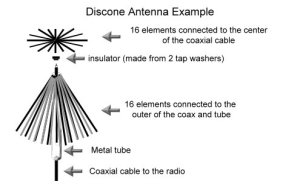Today we are going to look at the Discone antenna. These antenna’s are omnidirectional, And usually have a very large bandwidth range. They can be used on HF bands but it’s not very practical due to physical size. So these antenna’s are generally only used on the VHF band and above.
These Antenna’s do require more time and effort to build, The extra effort is rewarded by having an antenna that can cover a large section of the radio spectrum. This typically means 200 – 300 MHz range on the VHF or UHF bands. These antenna’s are sold commercially and usually have a 25MHz to 1.3 GHz range.
Things you will need
- Reel of copper wire (Must be thick enough to be self-supporting)
- A suitable length of coaxial cable.
- A suitable antenna plug
- A short piece of copper or aluminium tubing
- 2 tap washers ( 1 large and 1 slightly smaller, the smaller washer needs to fit snug in the inside the tube.).
- A discone Antenna calculator (Search the internet for this, There are lots of online and downloadable calculators)
How to construct
- Using the discone antenna calculator, Cut 8 equal lengths for the top part of the antenna (so they match the diameter of the top disc.).
- Cut each of the 8 elements into two equal parts, Now lay all 16 elements out in a circle ( so they almost touch at the center, leaving a 1 -2 mm center hole).
- Cut a 3 inch piece of wire (off the reel ) and form it into a circle, Solder the ends of the circle, Then lay it on the 16 elements in the center.
- Now solder the 16 elements to the circular loop that is laid on the top.
- Cut 16 more elements to the skirt length of the antenna.
- Cut a length of wire that just fits around the pipe, And solder the ends to form a circle (This needs to be reasonably tight, but not too tight)
- Strip 3 inches off one end of the coax, Feed the coax through the tube and bend the outer of the coax over the end of the tube (About 1/2 an inch is bent over the lip of the tube.).
- Now slide the loop back over the tube trapping the outer of the coax between the tube and the loop, Slide it down about 1/4 inch.
- Now glue the 2 rubber tap washers together, wait until they are dry.
- Slide the washers overs over the center dielectric (You made need to make the center hole a little larger.).
- Push the smaller washer inside the tube ( so the larger washer rests on the edge of the tube.
- Trim the dielectric off so only the center wire is showing ( The dielectric must be flush with the top of the washer.).
- Now take each of the 16 elements and solder them to the ring (That is around the tube.) at about a 30 degree angle from the tube, Remember to solder the outer of the coax too (try to evenly space the elements.) .
- Now take the top disc (With the small circle facing upwards) and align the elements so they are aligned to the lower elements, feed the center of the coax through the 1 – 2 mm hole, Pull it tight and solder the connection (Make sure you pull it tight, This holds the two halves of the antenna together.).
- solder your antenna plug to the other end of the coax.
That’s how to make a basic discone antenna, Traditionally these antenna’s are made with sheet metal materials. If you want to experiment with the number of radial’s, Then don’t go below 8 on the bottom and 8 on the top. If you try to use less than 8, It will start to perform poorly. This more radial’s you use, the better it will perform.
Example of a Discone Antenna
In my next post…
Yagi Antenna’s
Best regards
Simon

Thanks for the marvelous posting! I quite enjoyed reading it, you’re
a great author.I will be sure to bookmark
your blog and will eventually come back in the future.
I want to encourage you to ultimately continue your great work, have a nice day!
I used to be searching on search engines and I came across your own site. Good article you might have here. I have contributed it to my good friend who was searching for these kinds of info. I am confident this will help him a lot.
Thanks a lot for the information. Maintain on writing.
Excellent post, really informative, thank you